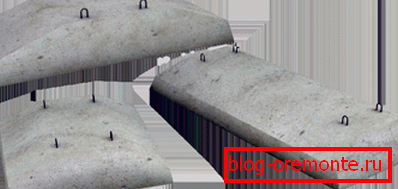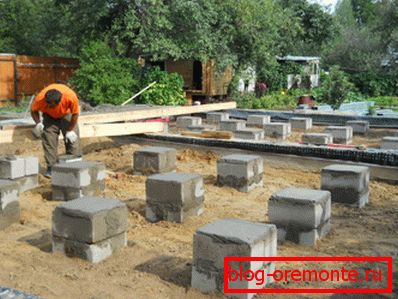The foundation of concrete blocks: familiarity with
How good is prefabricated basement compared to monolithic? Does this design have serious drawbacks? How quickly, for example, is the foundation made of concrete blocks 20x20x40 mm? Do I need a backing? What solution do the blocks hold together? We will try to answer these and many other questions in this article.

Materials
Let's start with a little research of the building materials market.
Types of blocks
On the pages of manufacturers and dealer companies you can find offers of base blocks of several types.
| Title | Description |
| PBS | Solid wall block of heavy concrete in the shape of a rectangular parallelepiped. |
| FBP | Пустотный блок той же формы. При меньшей по сравнению с PBS механической прочности отличается значительно меньшим весом и лучшими теплоизолирующими качествами. Цена, разумеется, тоже ниже. |
| FBV | It differs from the FBS longitudinal cut. Used to skip communications (wiring, water supply, sewage) under the ceiling of basements. |
| FL | Trapezoid-shaped sections designed exclusively for laying strip foundations. They differ from other products by more significant minimum sizes: the form implies stacking the blocks in one row. |
Любопытно: специфическое сечение блоков FL решает сразу две задачи. Давление строения распределяется по максимальной площади грунтового основания; кроме того, трапециевидный фундамент более эффективно противостоит морозному пучению: масса грунта будет удерживать его от выпирания.

Dimensions
Кроме типа, блоки маркируются цифрами, указывающими округленный до целого значения размер изделия в дециметрах. Так, блок FL 10-24-3 имеет ширину (по основанию трапеции) 1000 мм, длину 2380 мм и высоту 300 мм.
What size is optimal for self-construction?
The choice depends on the priorities.
- A larger block size means faster construction.. However, their installation in this case is possible only with the use of heavy machinery: it is clear that the FBS 24-6-6 unit, weighing nearly two tons, cannot be put into the pit manually. In addition, the size of the building in this case, willy-nilly, will be multiples of the size of the block, which is not always convenient.
- In contrast, blocks of minimum dimensions will make the construction of the foundation longer and somewhat reduce the rigidity of the structure.. But they can be moved and placed independently: the weight of the FBS 4-3-3 is about 80 kg, the smallest of the FBS blocks - 4-2-2 - weighs a little more than 30 kg.

Raw material
Is it always for the manufacture of foundation blocks used exclusively heavy concrete?
The answer is in the regulatory production of these products GOST 13579-78.
It involves the use of one of three materials:
- Heavy concrete with a density of 2400 kg / m3.
- Silicate concrete with a density of 2000 kg / m3.
- Керамзитобетона.
It is useful for a potential buyer to know one more thing about foundation blocks. At the time of delivery to the customer, they do not have to have brand strength.
| Strength class; type of concrete | Minimum strength at the time of delivery, as a percentage of brand |
| B12.5 and above; heavy concrete, lightweight aggregate | 50% |
| B10 and below; heavy concrete | 70% |
| B10 and below, expanded clay | 80% |
| Silicate concrete | 100% |
Useful: the foundation of expanded clay concrete blocks has better thermal insulation properties compared with heavy concrete; However, the material is more hygroscopic and requires careful waterproofing.

Advantages and disadvantages
Let's compare two designs:
- Precast strip foundation of prefabricated blocks;
- Monolithic strip foundation.
How does the first solution look like against the second?
Virtues
- Lower costs. According to the assurances of dealers of products of concrete plants, the final cost of the precast foundation is about 20% lower than that of the monolithic, even if the need to attract technology.
Please note: a significant part of the savings achieved by the lack of formwork. However, in the case when its role is played by the walls of the trench, the result of the comparison will not be so unequivocal.

- High speed construction. It will take much less time to lay the blocks and seal the joints than on the notorious formwork construction, the laying of the reinforcement and the preparation of the concrete.
- Readiness for further construction immediately after completion of work. In contrast to the precast, the monolithic foundation will require a long pause in the construction work: concrete, sufficient for building walls, will gain concrete in at least two weeks.
disadvantages
Actually, there is only one serious lack of design. The prefabricated base will be much less rigid than the monolith; it is able to deform without destruction during frost heaving and subsidence of the soil. This would be an advantage for a separate construction; however, the function of the foundation is precisely to exclude the transfer of deforming effects to the walls and floors.

The problem of insufficient rigidity of the base is partly solved by laying it below the freezing level: in this case, frost swelling is removed from the list of destabilizing factors. Possible subsidence of soil due to uneven density and erosion by rainwater are eliminated by the increased thickness of bedding.
Construction technology
Is it difficult to build a strip foundation with your own hands from concrete blocks?
Let's explore the construction technology.
- The trench is digging in the shape of the future foundation. It must be present under all bearing walls; besides, massive internal partitions usually rest on the tape base. The depth of the pit should be at least 25-30 cm higher than the depth of soil freezing in your area.
Attention: the layer of chernozem is removed to clay, sand or sandy loam. Even after tamping, he will not have sufficient bearing capacity.
- The trench is covered with sand. Backfill thickness is at least 20 centimeters. Sand will provide rainwater drainage; In addition, the sandy soil is unbutable: water will not linger in it and will not squeeze out fragments of the concrete foundation to the surface during frost.
- The bedding is rammed or spilled with plenty of water for maximum shrinkage.

- The foundation blocks are laid out in horizontal rows with mandatory ligation of vertical seams. The seams are filled with cement-sand mortar in a ratio of 1: 3; on the same solution laid out the next row of blocks. The gaps in the row are filled with blocks of shorter length, brickwork or monolithic inserts.
- On the upper edge of the finished foundation, roll waterproofing is required to fit (as a rule, two layers of roofing felt). The instruction is designed to prevent capillary leakage of water by walls and floors.
- The outer surface of the foundation is waterproofed with coating materials (usually molten bitumen or mastic based on it). Insulation at the same time reduces the adhesion between the ground and the blocks, thereby negating the effect of frost heaving.
- On non-rocky (sandy) soils, backfilling is done with soil. On clay and loams it is better to use sand and / or crushed stone. If for some reason this is not possible, a warmed blind area will interfere with the freezing of the soil in contact with the base.
Laying communications
How to make holes in the finished block foundation?
In general, concrete blocks perfectly takes any carbide tools.
However, diamond drilling holes in concrete against the background of the usual Pobedite drills and crowns has two advantages:
- The diamond tool does not require the use of a percussion mode and, as a result, does not give chipping, leaving the edges of the hole perfectly smooth.
- Drilling with a diamond bit, as well as cutting reinforced concrete with diamond circles, does not require a tool change when in contact with reinforcement. Diamond spraying allows you to cut steel along with concrete.

Conclusion
As usual, the video in this article will offer the reader additional thematic information. We hope that it will help determine the construction project and avoid mistakes in its process. Successes!